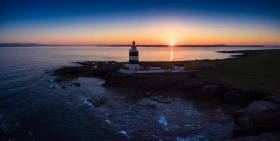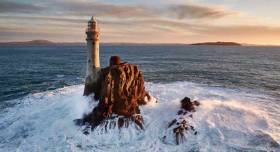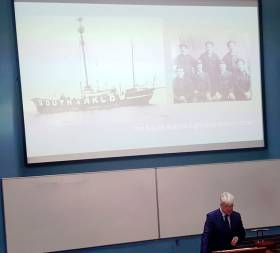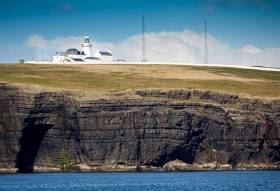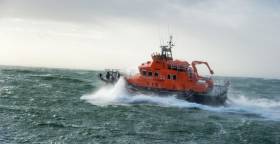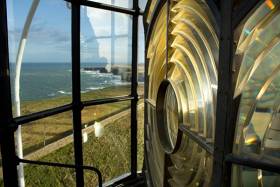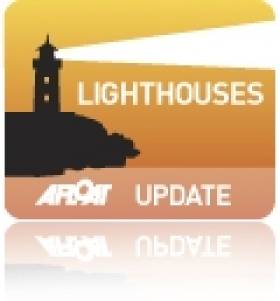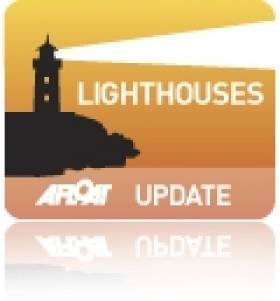Displaying items by tag: lighthouse
Panoramic Views on Offer as Old Head of Kinsale Lighthouse Opens to the Public for the Weekend
The Old Head of Kinsale Lighthouse, made famous for being the nearest point of land (11 miles/18 km) to where the RMS Lusitania was sunk in 1915, was open to the public this weekend writes Bob Bateman.
Under the supervision of a lighthouse keeper, visitors were treated to tours of the 100-foot lighthouse that boasts beautiful panoramic views of one of the country’s most scenic peninsulas, which is a highlight for visitors.
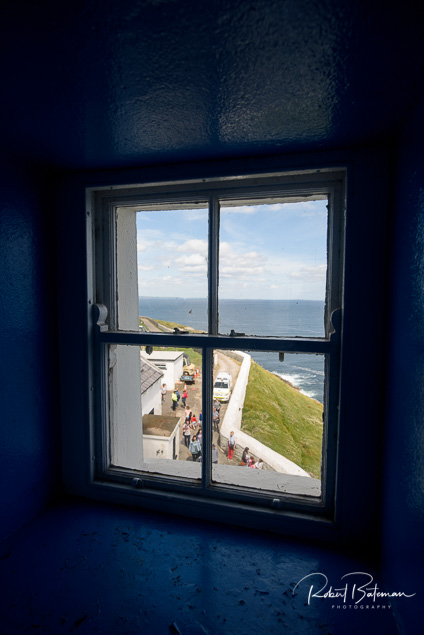
A shuttle bus service brought members of the public to and from the Old Head of Kinsale Signal Tower.
The 200-year-old Signal Tower at the Old Head has been restored to its former glory and is officially open to the public as a Lusitania Museum. The Museum exhibits artefacts recovered from the wreckage of the ship on the top floor.
The bottom floor of the narrow tower hosts an exhibition on the history of the tower itself.
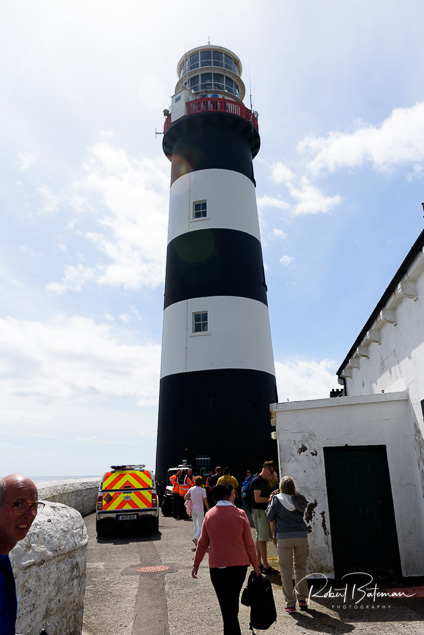 (Above and below) The tower height is 30 metres (98 ft)
(Above and below) The tower height is 30 metres (98 ft) The lighthouse is painted white with black horizontal bands
The lighthouse is painted white with black horizontal bands
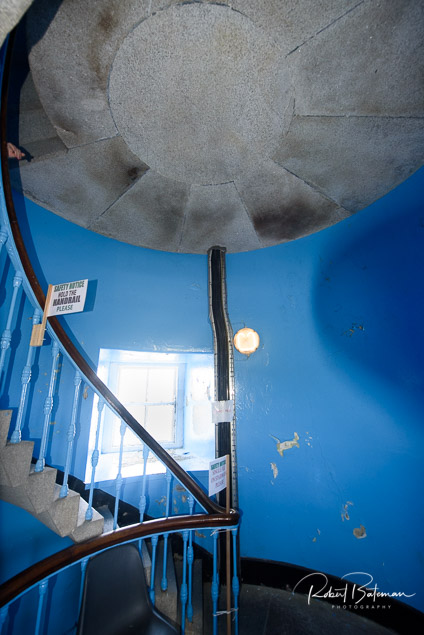 The lighthouse building is a cylindrical tower with a balcony and lantern
The lighthouse building is a cylindrical tower with a balcony and lantern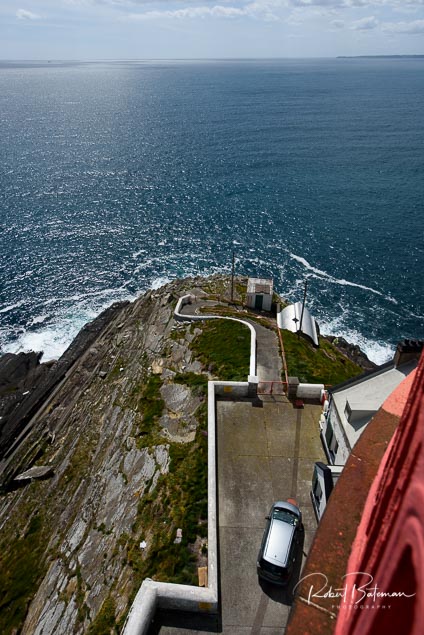 The Old Head of Kinsale Lighthouse is the nearest point of land (11 miles/18 km) to where the RMS Lusitania was sunk
The Old Head of Kinsale Lighthouse is the nearest point of land (11 miles/18 km) to where the RMS Lusitania was sunk The range of the light is 20 nautical miles
The range of the light is 20 nautical miles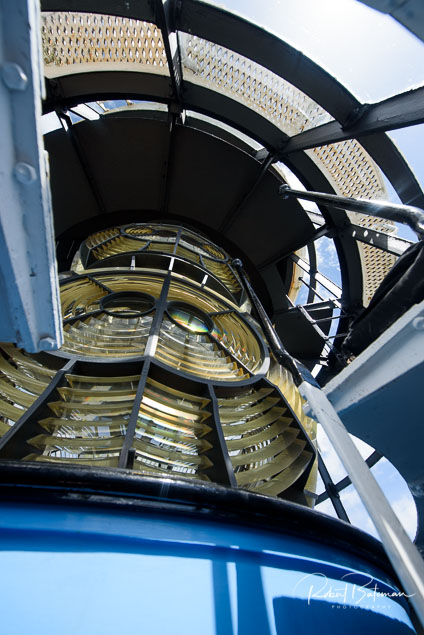

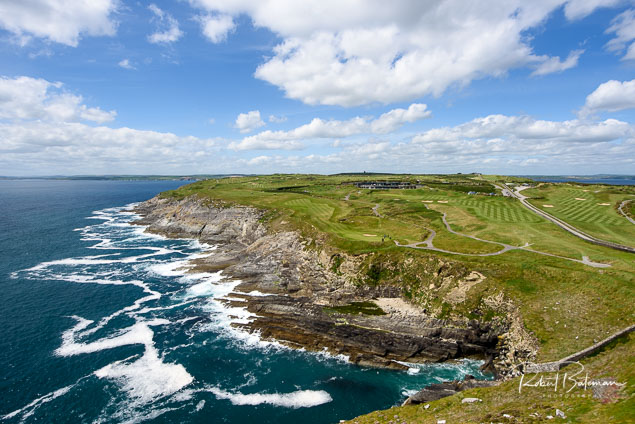 The Old Head of Kinsale is popular with golfers who come to play on its 18-hole golf course that opened in 1997
The Old Head of Kinsale is popular with golfers who come to play on its 18-hole golf course that opened in 1997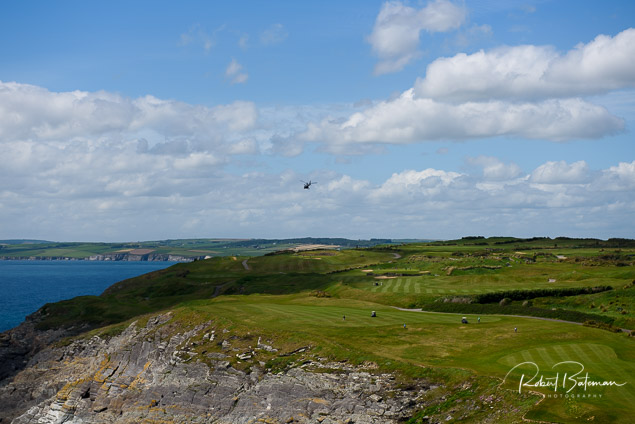
Hook Head on Good Friday – Another Lighthouse Experience
The world’s oldest original operational lighthouse at Hook Head has been developing a series of unusual events. To mark the “beginning of Spring” it celebrates Ireland’s ‘Fire Goddess', by staging the first Imbolc Festival to be celebrated at the 800-year-old lighthouse.
Now it has announced that it will host another unusual event this Good Friday - a Sunset Tour Experience.
Jutting out to sea at the tip of the Hook Peninsula on the corner of Ireland’s Ancient East, there is, the Hook Head Lighthouse people say “no better place to take in the vast seascapes and glorious colours of Ireland’s Celtic Sea.”
They are not short of words or ideas at Hook!
The Sunset Tour Experience will offer visitors the opportunity to take a guided tour up the 115 well-worn steps of the medieval tower and see its heritage come to life as they meet life-sized figures of the Monk who first kept a beacon alight at the site in the 5th century followed by the Knight who built the tower, William Marshal and hear of life as a light-keeper before stepping on to the top floor outdoor balcony to take in the 360degree sweeping views of the Southeast of Ireland as the sun goes down.
“Tours culminate with the spectacular panoramic views of the rolling seas stretching out while visitors savour Irish mead, prosecco, fresh tea and coffee along with Ballyhack smokehouse smoked salmon on homemade brown bread, a selection of homemade canapés and homemade mini desserts in the private lighthouse watch-room and balcony,” according to the announcement.
The Sunset Tours Experience is available by advance booking only. Tickets are €45.00 per person and the organisers say this is an “adult only experience.” Tickets can be booked online at www.hookheritage.ie or by calling 051 397055.
Free facilities at Hook Lighthouse in County Wexford include parking, toilets, garden picnic areas and Wifi.
The Fastnet Rock and its lighthouse – the most southerly part of Ireland - make up one of the best-recognised maritime structures in the world writes W M Nixon. Symbol, icon, emblem, signpost of the ocean – you name it, the Fastnet is all of these things. And the slender, beautifully-engineered lighthouse itself is central to the rock’s significance.
Since 1904 – after several previous attempts at placing a light on the rock - the glow of its beam has been moving every night along the glorious coast of West Cork. It is a familiar and much-loved part of that unique region’s heritage. It is impossible to imagine the area without it. And not surprisingly, many people want it to stay totally as it is, an unchanging constant in a changing world, a part of their lives as it was part of their parents’ and grandparents’ world before them
Yet with technology always advancing, inevitably the power source for the Fastnet Rock was becoming long out-dated, and increasingly costly to run. At the Irish Lights base in Dun Laoghaire, a new LED bulb has been developed which will provide a light in a much more economical way.
Yet if the new system is introduced, while it will still be a very powerful light, it will be one third less powerful than the present antiquated system. Naturally it is causing concern in West Cork. The Irish Times has the story here
The Irish Lights issued a statement about the South Arklow Lightship that didn’t tell the full story.
Their official explanation that it was missing off station was that it had “disappeared.”
In reality it had been sunk!
Dr. Michael Kennedy of the Royal Irish Academy, who is also Executive Editor of ‘Documents on Irish Foreign Policy’, had a remarkable story to tell when he referred to the “Irish amnesiac condition” which has ignored the importance of the sea around our nation. His example, which has left a strong impression on me, is that the history of the First World War focusses strongly on the big land battles in Europe – but Ireland, the Irish coastline and seafarers were on the front line of that war… as were the men of the South Arklow Lightship.
He told me the story, which hasn’t had a lot of public attention, at a maritime history conference in University College, Cork.
Listen to Dr. Kennedy on the Podcast here and also to a tragic story about 338 sailors lost off Bloody Foreland and the rescue by RNLI of a team playing football.
• Tom MacSweeney presents THIS ISLAND NATION radio programme on local stations around Ireland
Loop Head Lighthouse Visitor Numbers Up (Again) in 2016
A record number of people visited Loop Head Lighthouse on the Shannon Estuary in County Clare during 2016.
Figures from Clare County Council show that 27,274 people visited the lighthouse during the opening period up to Sunday 2 October compared to 27,010 during the same period in 2015.
The increase in visitors represents the fifth successive annual increase in visitor numbers at the West Clare landmark.
Clare County Council, which manages the Lighthouse in conjunction with the Commissioner of Irish Lights (CIL), first opened the popular visitor attraction to the public in 2011.
Loop Head Lighthouse, which is steeped in history and rich in maritime heritage with its origins dating back to the 1670s, is a landmark location on the Loop Head Heritage Trail. It is also one of two Signature Discovery Points in County Clare along the route of the Wild Atlantic Way and is one of 12 Great Lighthouses of Ireland that won a Silver award this week at the Responsible Tourism Awards.
#RNLI - Rosslare Harbour RNLI's volunteer crew launched their all-weather lifeboat at 2am this morning (Wednesday 30 March) on request by the Irish Coast Guard to attend an injured man who was working on the Tuskar Rock lighthouse.
Once on scene, 8km from Rosslare Harbour, the all-weather lifeboat deployed its Y-class rescue boat to reach the landing area on the rock, but due to a heavy swell a landing was not possible.
Lifeboat operations manager David Maloney had anticipated that scenario and had already requested the coastguard helicopter Rescue 117 from Waterford.
The helicopter was quickly on scene and lifted the injured man aboard, flying him to Waterford Airport where an ambulance was waiting to transfer him to hospital.
Apart from a heavy swell, weather conditions at the time were calm with a clear dry night. The lifeboat remained in the area until the airlift was completed and then returned to base at Rosslare Europort.
Commenting after the event, Maloney said: "The lifeboat crew were quite correct in not attempting to land on the rock due to a heavy Atlantic swell. We wish the man a full recovery."
Historic Loop Head Lighthouse Reopens to Public this Weekend
Loop Head Lighthouse in West Clare, one of the Great Lighthouses of Ireland, will reopen to the public this Saturday (March 12th 2016).
Clare County Council, which manages the facility in conjunction with the Commissioners of Irish Lights (CIL), says the historic lighthouse will remain open daily (10am-6pm) until October 2nd.
The popular tourist attraction attracted 26,932 visitors during 2015. The figure represents an increase of 6,564 or 32% on 2014 visitor numbers.
Loop Head Lighthouse is a landmark location on the Loop Head Heritage Trail which was named winner of the 'Culture and Heritage' category of the 2015 World Responsible Tourism Awards. It is also one of twelve lighthouses which make up Great Lighthouses of Ireland, a new all-island tourism initiative, and is one of two Signature Discovery Points in County Clare along the route of the Wild Atlantic Way.
Cllr. James Breen, Cathaoirleach of Clare County Council said the lighthouse has become "a key driver" of visitor numbers to the Loop Head Peninsula since it was first opened to the public in 2011.
He added, "Loop Head Lighthouse truly is one of the tourism success stories for County Clare in recent years. It has helped to strengthen the profile, both nationally and internationally, of the wider Loop Head Peninsula and what it has to offer as a tourism destination. Its promotion as a Signature Discovery Point along the route of the Wild Atlantic Way has also ensured that the attraction has been promoted both in Ireland and overseas, which is reflected in the origin of visitors."
Almost half of the total visitor figure during 2015 was represented by Irish visitors, with Germany, North America, UK, France and Italy collectively accounting for more than 42% of the overall figure.
Loop Head Lighthouse, located at the mouth of the Shannon Estuary, is steeped in history and rich in maritime heritage with its origins dating back to the 1670s. The existing tower style lighthouse was constructed in 1854 and was operated and maintained by a keeper who lived within the lighthouse compound. In January 1991, the lighthouse was converted to automatic operation, and today is in the care of an attendant and is also monitored by the CIL.
Admission to Loop Head Lighthouse, which includes the exhibition and guided tour of the site, is Adults (€5), Children (Under 14 - €2) and Family Passes for up to 2 adults + 3 children (€12). Visit www.loophead.ie or www.clare.ie for more information on Loop Head Lighthouse and the Loop Head Peninsula.
#lighthouses – A "brand new experience to take your breath away", that's the promise from Great Lighthouses of Ireland, a new EU INTERREG IVA funded tourism initiative being launched by the Commissioners of Irish Lights.
Featuring twelve lighthouses in stunning coastal locations, Great Lighthouses of Ireland will offer memorable, enriching experiences that inspire the senses, refresh the spirit and fire curiosity, creating a deep appreciation of the role of the sea, lighthouses, past and present, and the maritime and seafaring story of the island of Ireland.
With a range of services from accommodation to visitor centres and guided tours, visitors from home and abroad will have the chance to explore the distinct experiences offered by the lighthouses, each reflecting its own history and heritage, nature and environment, people and place, with aspects to appeal to people of all ages and interests.
The Great Lighthouses of Ireland project is supported by the European Union's INTERREG IVA cross-border Programme, managed by the Special EU Programmes Body. The ambitious and imaginative cross-border project will include the preservation and conservation of the island of Ireland's important maritime and lighthouse heritage. Great Lighthouses is built on a sustainable economic model and the re-invention of individual lighthouses as visitor attractions and specialist self-catering accommodation that can contribute to local communities in terms of jobs and specialist tourism.
Irish Lights operate over seventy lighthouses around the coast of Ireland. These lighthouses, including the Great Lighthouses of Ireland, still play a vital role in maritime safety.
Great Lighthouses of Ireland partners include the Irish Landmark Trust, the Royal Society for Protection of Birds, Forbairt Fhanada Teoranta (Fanad Community Group), Clare County Council, Ballycotton Lighthouse Tours, Mid & East Antrim Borough Council, Hook Heritage limited, Valentia Island Development Company, Kerry County Council and Clare Island Lighthouse. Great Lighthouses of Ireland is also supported by Tourism Ireland, Fáilte Ireland and Tourism Northern Ireland.
Great Lighthouses of Ireland
St John's Point, Co Donegal
Fanad Head, Co Donegal
Rathlin West Light, Co Antrim
Blackhead, Co Antrim
St John's Point, Co Down
Wicklow Head, Co Wicklow
Hook, Co Wexford
Ballycotton, Co Cork
Galley Head, Co Cork
Valentia Island, Co Kerry
Loop Head, Co Clare
Clare Island, Co Mayo
International Peer Review Confirms Aids to Navigation Requirements for the Irish Coast to 2020
#lighhousereview – The General Lighthouse Authorities for the UK and Ireland have now completed their latest 5 yearly comprehensive review of Aids to Navigation (AtoN) requirements for the waters around Ireland and the United Kingdom. User Feedback, Automatic Identification System (AIS) traffic analysis, Targeted User Consultation, Navigational Significance Assessments, Risk Assessments and Peer Review were all used to help define ongoing User Requirements. The full document is downloadable below as a pdf document.
The following principles were applied during the review process to ensure consistency:
• Generally having one light in view is acceptable
• Generally a max range of 18 Nautical Miles is considered sufficient for most lights
• If practical there can be a reduction in amount and diversity of flash characters on lighthouse lights
• Leading Lights remain important
• Sectored Lights remain important
• Synchronised and Sequential Buoy lights can be used more
The decisions were made following consultation with users and representative organization's across the whole spectrum of the industry from large SOLAS vessels to leisure users and the fishing sector.
A summary of the changes that Irish Lights will make is as follows:
• Establish RACON at the Foyle Buoy due to increased large vessel traffic
• Open negotiations to upgrade to general AtoN status' Bloody Foreland Light as analysis has shown General Traffic is transiting the area
• Disestablish the Pollock Buoy as the Power South Cardinal has made this Buoy redundant
• Replace the Briggs Port Hand Buoy with a North Cardinal Buoy to provide a clearer indication of the position of the danger
• Establish a Buoy in place of the Unlit Carrigavadra Beacon
• Sequence Buoyage at the entrance to Rosslare
Capt. Harry McClenahan Navigation Manager at Irish Lights said "The rate of technological changes in navigation support systems and materials has had a significant and positive effect on the services that Irish Lights provides to the Mariner, allowing for higher performance yet lower power demands from our stations. We are in the embryonic phase of the evolution of digital systems which are already starting to shape the future of marine navigation and communications. To ensure that safety of persons and property and environmental protection remain as the main focus for future navigation services we use our resources, experience and competency to explore and trial new systems and materials."
The 2015 Aids to Navigation Review was launched yesterday at the Joint Users Consultative Group Meeting in Trinity House London. The changes will be phased in over the coming years and will be fully promulgated in advance by Notice to Mariners.
Anne Doyle Launches Tourist Season at Loop Head Lighthouse
#loophead – Former RTE newsreader and lighthouse enthusiast, Anne Doyle was in West Clare today where she joined Councillor John Crowe, Cathaoirleach of Clare County Council, in launching Loop Head Lighthouse's 2015 tourist season.
The historic landmark commenced its 5th year of operations when it reopened to the public on 03 April last. Clare County Council, which manages Loop Head Lighthouse in conjunction with the Commissioners of Irish Lights (CIL), says the facility will remain open daily (10am-6pm) until 4th October 2015.
Anne Doyle has been captivated by lighthouses since her childhood in Ferns, County Wexford, where she grew up observing the sweeping lights of the Tuskar Rock Lighthouse.
"Ireland's lighthouses hold so much history and are located in some of Western Europe's most scenic settings. Loop Head is no exception and the location of the lighthouse on the tip of the majestic Loop Head Peninsula and at the mouth of the Shannon Estuary makes it extra special," said Ms. Doyle.
Commenting on the launch of the 2015 visitor season, Councillor John Crowe said: "The 19th century West Clare landmark will be looking to capitalise on its designation as a Signature Discovery Point on the Wild Atlantic Way and further promote the economic development of the Loop Head Peninsula."
"Visitor numbers at the lighthouse have continued grow year on year since it was first opened to the public in 2011. During this time the lighthouse has delivered a major boost to economic activity in the wider area and I am confident it will further build on this in the months and years ahead," he added.
Loop Head Lighthouse is steeped in history and rich in maritime heritage with its origins dating back to the 1670s. The existing tower style lighthouse was constructed in 1854 and was operated and maintained by a keeper who lived within the lighthouse compound. Taoiseach Enda Kenny's grandfather was a keeper at the lighthouse. James John McGinley took up duty at the Lighthouse as Principal Keeper on 16th January 1933. He spent 1 year and 10 months at Loop Head. He was transferred from the station in October 1934.
Located to the rear of the lighthouse is an Éire sign etched into the headland, which was used to alert passing Allied aircrews that they were passing over neutral Ireland during World War Two.
In January 1991, the lighthouse was converted to automatic operation, and today is in the care of an attendant and is also monitored by the CIL.




























